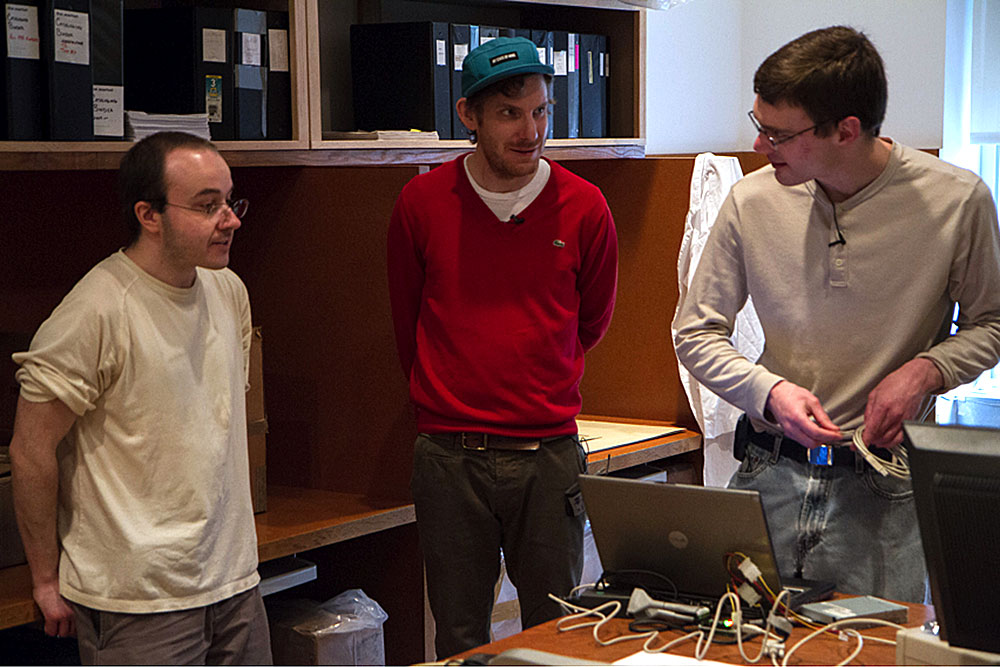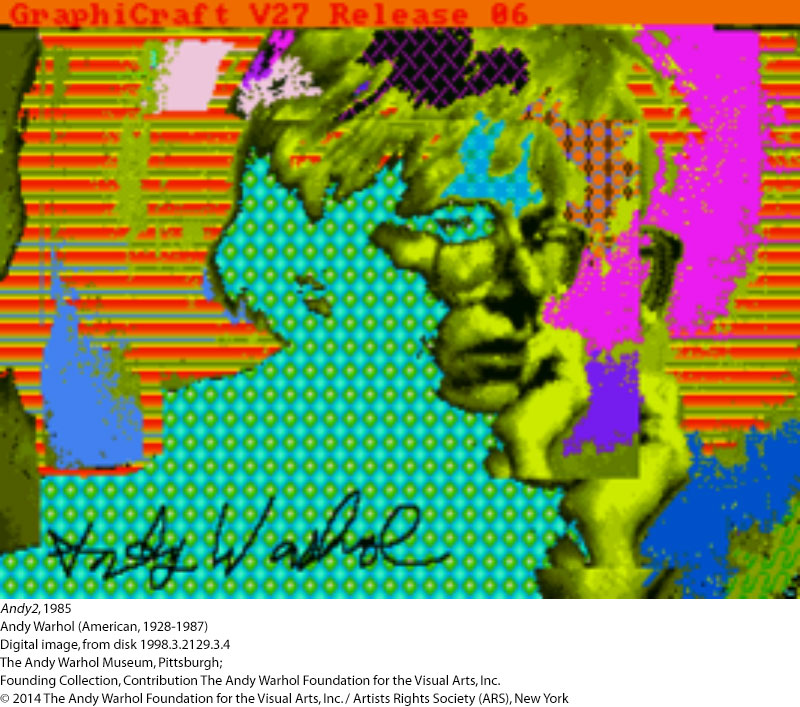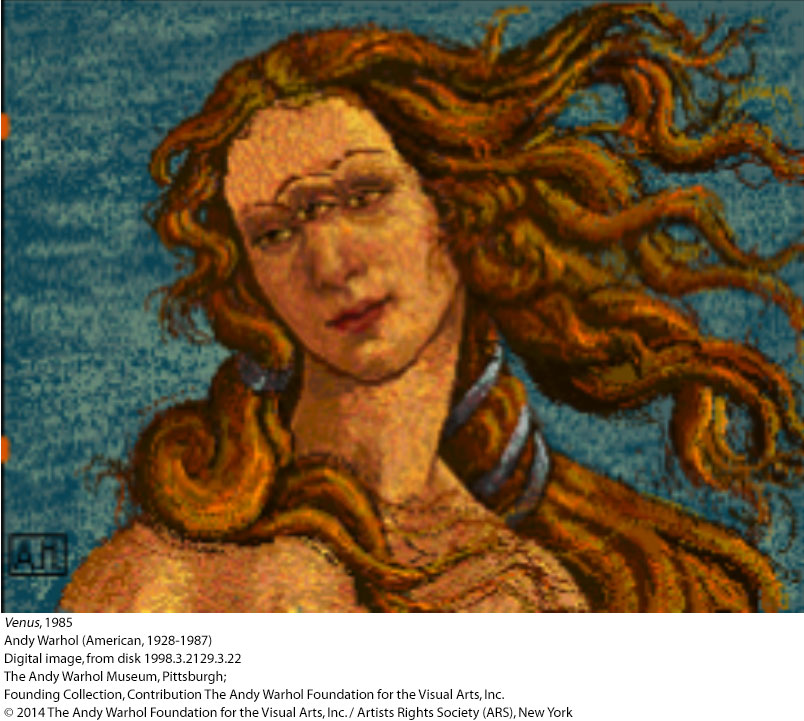Previously Unknown Warhol Works Discovered on Floppy Disks from 1985 An Unusual Collaboration Rescues Early Digital Art through “Forensic Retrocomputing”
Pam WigleyThursday, April 24, 2014Print this page.

PITTSBURGH—A multi-institutional team of new-media artists, computer experts, and museum professionals have discovered a dozen previously unknown experiments by Andy Warhol (BFA, 1949) on aging floppy disks from 1985.
The purely digital images, “trapped” for nearly 30 years on Amiga® floppy disks stored in the archives collection of The Andy Warhol Museum (AWM), were discovered and extracted by members of the Carnegie Mellon University (CMU) Computer Club, with assistance from the AWM’s staff, CMU’s Frank-Ratchye STUDIO for Creative Inquiry (FRSCI), the Hillman Photography Initiative at the Carnegie Museum of Art (CMOA), and New York based artist Cory Arcangel.
Warhol’s Amiga experiments were the products of a commission by Commodore International to demonstrate the graphic arts capabilities of the Amiga 1000 personal computer. Created by Warhol on prototype Amiga hardware in his unmistakable visual style, the recovered images reveal an early exploration of the visual potential of software imaging tools, and show new ways in which the preeminent American artist of the 20th century was years ahead of his time.
The impetus for the investigation came when Arcangel, a self-described “Warhol fanatic and lifelong computer nerd,” learned about Warhol's Amiga experiments from a 1985 Commodore infomercial on YouTube. Acting on a hunch, and with the support of CMOA curator Tina Kukielski, Arcangel approached the AWM in December 2011 regarding the possibility of restoring the Amiga hardware in the museum’s possession, and cataloging any files on its associated diskettes. In April 2012, he contacted Golan Levin, a CMU art professor and director of the FRSCI, a laboratory that supports “atypical, anti-disciplinary and inter-institutional” arts research. Offering a grant to support the investigation, Levin connected Cory with the CMU Computer Club, a student organization that had gained renown for its expertise in “retrocomputing,” or the restoration of vintage computers.
CMU Computer Club members determined that even reading the data from the diskettes entailed significant risk to the contents, and would require unusual tools and methodologies. By February 2013, in collaboration with collections manager Amber Morgan and other AWM archivists, the Club had completed a plan for handling the delicate disk media, and gathered at The Andy Warhol Museum to see if any data could be extracted. The Computer Club set up a cart of exotic gear, while a video crew from the Hillman Photography Initiative, under the direction of Kukielski, followed their progress.
It was not known in advance whether any of Warhol’s imagery existed on the floppy disks—nearly all of which were system and application diskettes onto which, the team later discovered, Warhol had saved his own data. Reviewing the disks’ directory listings, the team’s initial excitement on seeing promising filenames like “campbells.pic” and “marilyn1.pic” quickly turned to dismay, when it emerged that the files were stored in a completely unknown file format, unrecognized by any utility. Soon afterwards, however, the Club’s forensics experts had reverse-engineered the unfamiliar format, unveiling 28 never-before-seen digital images that were judged to be in Warhol's style by the AWM’s experts. At least eleven of these images featured Warhol’s signature.
The images depict some of Warhol’s best-known subjects—Campbell’s® soup cans, Botticelli’s Venus, and self-portraiture, for example—articulated through uniquely digital processes such as pattern flood fills, palletized color, and copy-paste collage. “What's amazing is that by looking at these images, we can see how quickly Warhol seemed to intuit the essence of what it meant to express oneself, in what then was a brand-new medium: the digital,” says Arcangel.
The team’s efforts are documented in the Hillman Photography Initiative’s new short film, “Trapped: Andy Warhol’s Amiga Experiments.” Trapped will premiere at 7 p.m., Saturday, May 10, at Carnegie Library Lecture Hall in Pittsburgh. The screening will be followed by a conversation with some of the team’s key players, including artists Arcangel and Levin; Michael Dille, who just completed his Ph.D. in robotics at CMU, and Keith A. Bare of the CMU Computer Club; and outside guest Jon Ippolito, a professor of digital media curation at the University of Maine. The Trapped documentary will be available online at http://nowseethis.org on May 12.
A detailed report about the CMU Computer Club’s retrocomputing work on the Warhol/Amiga image recovery project can be found here: http://studioforcreativeinquiry.org/public/warhol_amiga_report_v10.pdf
About the Frank-Ratchye STUDIO for Creative Inquiry:
(http://studioforcreativeinquiry.org) The Frank-Ratchye STUDIO for Creative Inquiry is a flexible laboratory for new modes of arts research, production and presentation. Founded in 1989 within the College of Fine Arts at Carnegie Mellon University (CMU), the STUDIO serves as a locus for hybrid enterprises on the CMU campus, the Pittsburgh region, and internationally. The STUDIO’s mission is to support atypical, anti-disciplinary and inter-institutional research projects at the intersections of arts, sciences, technology and culture. The laboratory's current emphasis on new-media arts builds on more than two decades of experience hosting interdisciplinary artists in an environment enriched by world-class science and engineering departments. The STUDIO provided logistical and financial support for the Warhol/Amiga project through its endowment for special projects, the Frank-Ratchye Fund for Art @ the Frontier.
About the Carnegie Mellon University Computer Club:
(http://www.club.cc.cmu.edu/) The CMU Computer Club is a student organization at Carnegie Mellon University that provides customized computing solutions for power users throughout the campus community. The Club is known for its retrocomputing expertise through its various restoration projects, hardware development initiatives, prize-winning multimedia "demo" authoring, and annual exhibitions conducted on modern and historic hardware. The Club also possesses one of the largest collections of functioning, historic computer hardware in the country. Club members Keith A. Bare and Michael Dille were the primary contributors to the Warhol/Amiga retrocomputing effort, with additional yet essential contributions from Tyler Nighswander, Derek Kozel, and Lincoln Roop.
About the Carnegie Museum of Art:
(http://www.cmoa.org) Located at 4400 Forbes Avenue in the Oakland section of Pittsburgh, Carnegie Museum of Art was founded by industrialist and philanthropist Andrew Carnegie in 1895. One of the four Carnegie Museums of Pittsburgh, it is nationally and internationally recognized for its distinguished collection of American and European painting, sculpture, and decorative arts from the 19th century to the present. Through its Hillman Photography Initiative, which serves as an incubator for innovative thinking about the photographic image, the Carnegie Museum of Art produced “Trapped: Andy Warhol’s Amiga Experiments,” a documentary short film about the Warhol/Amiga recovery project.
About The Andy Warhol Museum:
(http://www.warhol.org) Located in Pittsburgh, Pennsylvania, the place of Andy Warhol's birth, The Warhol is one of the most comprehensive single-artist museums in the world. In addition to its extensive art and film collections, The Warhol also maintains the Warhol Archives: a collection of over 8,000 cubic feet of material – perhaps half a million objects – including the Amiga computer hardware from which previously unknown digital artworks by Warhol were recently recovered. The Andy Warhol Museum is one of the four Carnegie Museums of Pittsburgh.
About Cory Arcangel:
(http://www.coryarcangel.com/) Cory Arcangel is a Brooklyn-based new-media artist and self-proclaimed Warhol acolyte who has produced works that explore the relationship between technology and culture. His work has been exhibited internationally in numerous group and solo shows at many institutions including the Migros Museum in Zurich, the Carnegie Museum of Art in Pittsburgh, and the Hamburger Bahnhof in Berlin. His online work, source code, ephemera, mp3s, etc., etc., can be found at http://www.coryarcangel.com/. His work has been profiled in The New Yorker, The Guardian, and The New York Times; in 2011, he became the youngest artist since Bruce Nauman to be honored with a full floor solo show at the Whitney Museum of American Art in New York. Arcangel conceived and initiated the Warhol/Amiga recovery project.
Support:
Financial support for the Warhol/Amiga data recovery project came from the Frank-Ratchye Fund for Art @ the Frontier, an endowment to encourage innovative arts research by the faculty, students and staff of Carnegie Mellon University.
The Carnegie Museum of Art, and the Frank-Ratchye STUDIO for Creative Inquiry at Carnegie Mellon University, receive state arts funding support through grants from the Pennsylvania Council on the Arts, a state agency funded by the Commonwealth of Pennsylvania.
General operating support for the Carnegie Mellon University Computer Club comes from the CMU Student Activities Fee and the CMU School of Computer Science. General operating support for the Carnegie Museum of Art is provided by The Heinz Endowments and Allegheny Regional Asset District. Support for the Carnegie Museum of Art's Hillman Photography Initiative was provided by the William T. Hillman Foundation, and the Henry L. Hillman Foundation.
Images are available from The Andy Warhol Museum pressroom at http://www.warhol.org/museum/pressroom/.
Persons or organizations seeking to reproduce the images accompanying this press release should contact both of the following persons for necessary permissions:
Greg Burchard / BurchardG@warhol.org / +1-412-237-8336
Senior Manager of Rights and Reproductions, The Andy Warhol Museum
Janet Hicks / jhicks@arsny.com / +1-212-420-9160
Director of Permissions, Artists Rights Society (ARS)



Pam Wigley | 412-268-1047 | <a href="mailto:pwigley@andrew.cmu.edu">pwigley@andrew.cmu.edu</a>
